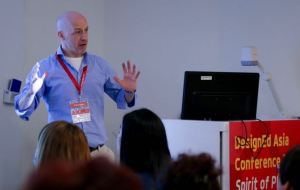To continue my unravelling of ‘evidenced informed education’ it is interesting to examine how other fields are also struggling to identify how best to move towards a more robust evidence base. Most recently I attended a design conference where the very same points were being made about the lack of an evidence base informing practice.
At the conference it was argued both for and against a ‘scientific methods’ however I recently read this from Nassim Taleb – “It is wrong to say that Scientific method is based on evidence – it is based on knowing how to deal with the absence of evidence.” This to me strikes at the heart of education – what do you do in the absence of evidence?
Some elements of education are based on general ‘evidenced’ principles and informed models (as in the recent Sutton report) – although perhaps not as many as we think. Whilst some – perhaps even most – aspects of education are unique contexts where the broad principles can no longer be applied. This is where we often rely on anecdotes (sometimes valid), tacit knowledge and intuition in the absence of applicable evidence.
This is probably what characterizes a lot of classroom situations – instinctively doing what is perceived as right or doing what you are told is correct. Yet this is the point where there is the greatest need for informed positions as doing what is perceived is correct, what your intuition and instincts tell you is fraught with complexities and baggage.
I have written a lot about decision making with the culmination of all this writing being we are not robust in our judgments. Therefore in the absence of robust evidence we can’t solely trust our judgments. This is why the often derided and misunderstood notion of ‘critical reflection’ or ‘critical practitioner is such an important concept in education – yet we all need the correct tools to be able to critique and reflect.
What is perhaps positive in the current climate of social media led discussions of education is that there has been a positive increase in critiquing (although often it can merely be criticizing) but often it isn’t always sufficiently reflective or reflexive. Therefore returning back to the call for evidenced based approaches in education it is also tempting to think that all is rosy in the medical world and that their decision making is robust; far from it.
This is illustrated by a significant growth in research (which I have previously drawn upon) into poor decision making in the medical field – which have often resulted in huge litigations. Equally definitions of evidenced based medicine also illustrate that evidence is only one part of the decision-making as ethics and compassion also factor into the equation. In fact one of the fears of evidence based calls in education is the reductive nature of some of the suggestion whereas as exemplified below the evidence based medical practice is fraught with complexities and far from clear cut and recognizes this as such:
“Increased expertise is reflected in many ways, but especially in more effective and efficient diagnosis and in the more thoughtful identification and compassionate use of individual patients’ predicaments, rights, and preferences in making clinical decisions about their care. By best available external clinical evidence we mean clinically relevant research, often from the basic sciences of medicine, but especially from patient centred clinical research into the accuracy and precision of diagnostic tests (including the clinical examination), the power of prognostic markers, and the efficacy and safety of therapeutic, rehabilitative, and preventive regimens” (Sackett, 1996, p. 71).
Ultimately education remains ‘fragmentally conceptualized’, messy and complex and moving towards more informed positions is completely desirable. How this is achieved, and what forms of evidence are considered as valid is where much of the debate needs to be focused.
